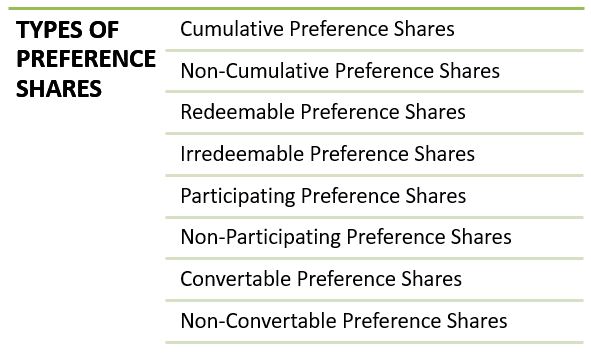Preference shares are those shares which give preferential rights to its holders to receive dividend and get back the initial investment at the time of winding up of the company.
Preference shareholders as the name suggest enjoy preference over the payment of dividend. The dividend paid on these shares is generally at a fixed rate. They don’t have voting rights but they are eligible to get a fixed rate of dividend.
Features of Preference Shares
- Maturity period – It has no fixed maturity period except in the case of redeemable preference shares. It can be redeemable at the time of liquidation of the company.
- Claim on Income – Preference shareholders have a residual claim on income. They are paid a fixed rate of dividend.
- Claim on Assets – Preference shareholders have a residual claim on company assets too. Preference is given to the preference shareholders at the time of liquidation.
- Control – Preference shareholders have no control over the management as they have no voting rights.
Advantages of Preference Shares
- Fixed Dividend – Dividend rate is fixed in case of these shares, it provides a fixed rate of income to its holders.
- Redemption – They are redeemable in nature as they can be redeemed after a specific period.
- Convertibility – They are convertible in nature. They can be converted into equity shares whenever the need arises.
- Cumulative Dividend – One more advantage of these shares is they can have a cumulative dividend. If the company does not earn any profit in any year, the dividend for that year can be cumulated with future dividends.
- Raising capital – It is one of the most common source for long term finance. It helps in raising long term capital for the company.
Disadvantages of Preference Shares
- No voting rights – Preference shareholders have no voting rights which means they have no control over the management.
- Permanent burden – Cumulative preference become the permanent burden for the management because the company has to pay the dividend even for the unprofitable period.
- Taxation – They are not a deductible expense while calculating tax.
- Expensive – They are an expensive source of finance compared to equity shares.
Types of Preference Shares

Cumulative Preference Shares – Cumulative preference shares are those which have the right to claim dividend even for those years in which the company has no profit. If the company does not earn any profit, they are unable to get any dividend but they have the right to get the cumulative dividend for the previous year if the company earns a profit.
Non-Cumulative Preference Shares – Non-cumulative preference shares have no right to claim dividends when there is no profit. They don’t enjoy these benefits.
Redeemable Preference Shares – Redeemable Preference shares become redeemable when they have a fixed maturity period. It can be redeemable during the lifetime of the company.
Irredeemable Preference Shares – Irredeemable preference shares are those which can only be redeemed after the company`s liquidation.
Participating Preference Shares – Participative shareholders are those which participate in the extra profit of the company. If some profit remains after paying dividends then they can claim for the remaining extra profit.
Non-Participating Preference Shares – Only a fixed rate of dividend is paid on these shares. Shareholders of these shares do not have the right to claim for extra remaining profit.
Convertible Preference Shares – The holders of these shares are given the right to convert their shares into equity shares after a specific period.
Non-Convertible Preference Shares – Those preference shares which cannot be converted into equity shares are called non-convertible preference shares.